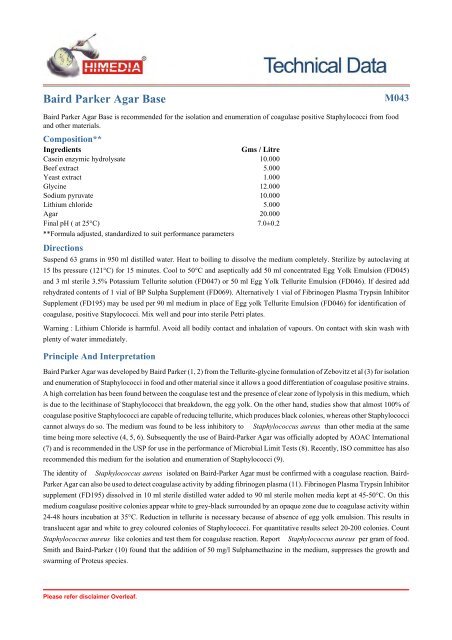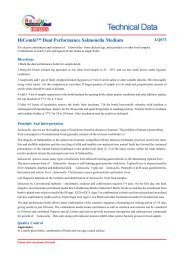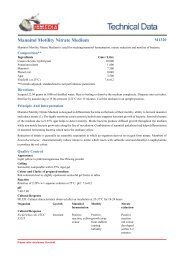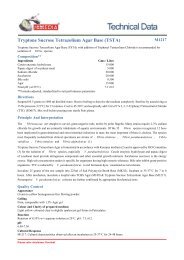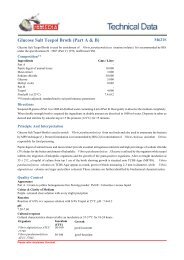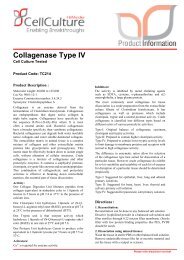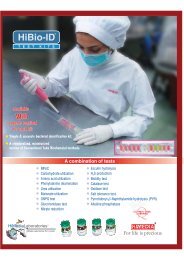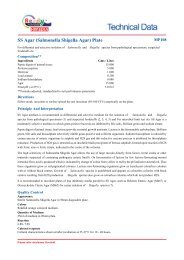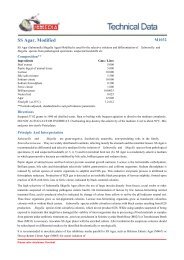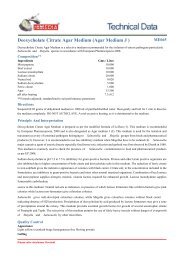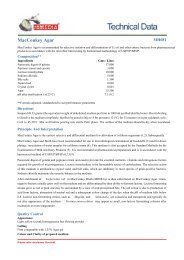Baird Parker Agar Base - HiMedia Laboratories
Baird Parker Agar Base - HiMedia Laboratories
Baird Parker Agar Base - HiMedia Laboratories
You also want an ePaper? Increase the reach of your titles
YUMPU automatically turns print PDFs into web optimized ePapers that Google loves.
<strong>Baird</strong> <strong>Parker</strong> <strong>Agar</strong> <strong>Base</strong><br />
<strong>Baird</strong> <strong>Parker</strong> <strong>Agar</strong> <strong>Base</strong> is recommended for the isolation and enumeration of coagulase positive Staphylococci from food<br />
and other materials.<br />
Composition**<br />
Ingredients Gms / Litre<br />
Casein enzymic hydrolysate 10.000<br />
Beef extract 5.000<br />
Yeast extract 1.000<br />
Glycine 12.000<br />
Sodium pyruvate 10.000<br />
Lithium chloride 5.000<br />
<strong>Agar</strong> 20.000<br />
Final pH ( at 25°C) 7.0±0.2<br />
**Formula adjusted, standardized to suit performance parameters<br />
Please refer disclaimer Overleaf.<br />
M043<br />
Directions<br />
Suspend 63 grams in 950 ml distilled water. Heat to boiling to dissolve the medium completely. Sterilize by autoclaving at<br />
15 lbs pressure (121°C) for 15 minutes. Cool to 50°C and aseptically add 50 ml concentrated Egg Yolk Emulsion (FD045)<br />
and 3 ml sterile 3.5% Potassium Tellurite solution (FD047) or 50 ml Egg Yolk Tellurite Emulsion (FD046). If desired add<br />
rehydrated contents of 1 vial of BP Sulpha Supplement (FD069). Alternatively 1 vial of Fibrinogen Plasma Trypsin Inhibitor<br />
Supplement (FD195) may be used per 90 ml medium in place of Egg yolk Tellurite Emulsion (FD046) for identification of<br />
coagulase, positive Stapylococci. Mix well and pour into sterile Petri plates.<br />
Warning : Lithium Chloride is harmful. Avoid all bodily contact and inhalation of vapours. On contact with skin wash with<br />
plenty of water immediately.<br />
Principle And Interpretation<br />
<strong>Baird</strong> <strong>Parker</strong> <strong>Agar</strong> was developed by <strong>Baird</strong> <strong>Parker</strong> (1, 2) from the Tellurite-glycine formulation of Zebovitz et al (3) for isolation<br />
and enumeration of Staphylococci in food and other material since it allows a good differentiation of coagulase positive strains.<br />
A high correlation has been found between the coagulase test and the presence of clear zone of lypolysis in this medium, which<br />
is due to the lecithinase of Staphylococci that breakdown, the egg yolk. On the other hand, studies show that almost 100% of<br />
coagulase positive Staphylococci are capable of reducing tellurite, which produces black colonies, whereas other Staphylococci<br />
cannot always do so. The medium was found to be less inhibitory to Staphylococcus aureus than other media at the same<br />
time being more selective (4, 5, 6). Subsequently the use of <strong>Baird</strong>-<strong>Parker</strong> <strong>Agar</strong> was officially adopted by AOAC International<br />
(7) and is recommended in the USP for use in the performance of Microbial Limit Tests (8). Recently, ISO committee has also<br />
recommended this medium for the isolation and enumeration of Staphylococci (9).<br />
The identity of Staphylococcus aureus isolated on <strong>Baird</strong>-<strong>Parker</strong> <strong>Agar</strong> must be confirmed with a coagulase reaction. <strong>Baird</strong>-<br />
<strong>Parker</strong> <strong>Agar</strong> can also be used to detect coagulase activity by adding fibrinogen plasma (11). Fibrinogen Plasma Trypsin Inhibitor<br />
supplement (FD195) dissolved in 10 ml sterile distilled water added to 90 ml sterile molten media kept at 45-50°C. On this<br />
medium coagulase positive colonies appear white to grey-black surrounded by an opaque zone due to coagulase activity within<br />
24-48 hours incubation at 35°C. Reduction in tellurite is necessary because of absence of egg yolk emulsion. This results in<br />
translucent agar and white to grey coloured colonies of Staphylococci. For quantitative results select 20-200 colonies. Count<br />
Staphylococcus aureus like colonies and test them for coagulase reaction. Report Staphylococcus aureus per gram of food.<br />
Smith and <strong>Baird</strong>-<strong>Parker</strong> (10) found that the addition of 50 mg/l Sulphamethazine in the medium, suppresses the growth and<br />
swarming of Proteus species.
<strong>HiMedia</strong> <strong>Laboratories</strong> Technical Data<br />
Casein enzymic hydrolysate, peptic digest of animal tissue, beef, meat and yeast extract are sources of nitrogen, carbon, sulphur<br />
and vitamins. Sodium pyruvate not only protects injured cells and helps recovery but also stimulates Staphylococcus aureus<br />
growth without destroying selectivity. Lithium chloride and potassium tellurite inhibit most of the contaminating microflora<br />
except Staphylococcus aureus . The tellurite additive is toxic to egg yolk-clearing strains other than S. aureus and<br />
imparts a black colour to the colonies. Glycine, pyruvate enhances growth of Staphylococcus . With the addition of egg<br />
yolk, the medium becomes yellow, opaque. The egg yolk additive, in addition to provide enrichment, aids in the identification<br />
process by demonstrating lecithinase activity (egg yolk reaction). A clear zone and grey-black colonies on this medium are<br />
diagnostic for coagulase positive Staphylococci. Upon further incubation, an opaque zone is developed around colonies, which<br />
can be due to lipolytic activity.<br />
When testing the medium, inoculate the material to be examined (0.1 ml per plate of diameter 90-100 mm), incubate at 37°C<br />
and take the first reading after 24-26 hours. The colonies of Staphylococcus aureus are black and shiny, with a fine white rim,<br />
surrounded by a clear zone. Incubate at 37°C for another 24 hours and perform the coagulase test on the colonies with the above<br />
characteristics, which have developed during the further incubation period. Plates should be used on the same day of preparation<br />
or within 48 hours, to avoid the loss of definition in the precipitated zones. The basal medium, without the egg yolk or the<br />
tellurite, is perfectly stable. Colonies of some contaminating organisms may digest the coagulase halo reaction. Other bacteria<br />
may grow on this media but biochemical test will differentiate coagulase positive Staphylococci from the other organisms.<br />
Quality Control<br />
Appearance<br />
Cream to yellow homogeneous free flowing powder<br />
Gelling<br />
Firm, comparable with 2.0% agar gel.<br />
Colour and Clarity of prepared medium<br />
Basal medium: Yellow coloured clear to slightly opalescent gel. After addition of Egg Yolk Emulsion and Tellurite<br />
Emulsion: Yellow coloured opaque gel forms in Petri plates.<br />
Reaction<br />
Reaction of 6.3% w/v aqueous solution at 25°C. pH : 7.0±0.2<br />
pH<br />
6.80-7.20<br />
Cultural Response<br />
Cultural response was observed after an incubation at 35-37°C for 24-48 hours. Recovery rate is considered as 100% for<br />
bacteria growth on Soyabean Casein Digest <strong>Agar</strong>.<br />
Cultural Response<br />
Organism Inoculum<br />
(CFU)<br />
Staphylococcus aureus<br />
ATCC 6538<br />
Staphylococcus aureus<br />
ATCC 25923<br />
Please refer disclaimer Overleaf.<br />
Growth Lot value<br />
(CFU)<br />
Recovery Colour of<br />
colony<br />
50 -100 luxuriant 25 -100 >=50 % grey-black<br />
shiny<br />
50 -100 luxuriant 25 -100 >=50 % grey-black<br />
shiny<br />
Lecithinase<br />
Positive,<br />
opaque zone<br />
around the<br />
colony<br />
Positive,<br />
opaque zone<br />
around the<br />
colony<br />
Proteus mirabilis ATCC<br />
25933<br />
50 -100 good - luxuriant50 -100 >=50 % brown - black Negative<br />
Micrococcus luteus ATCC 50 -100 poor - good 15 -40 30 -40 % shades of Negative<br />
10240<br />
brown-black<br />
(very small)<br />
Staphylococcus epidermidis<br />
ATCC 12228<br />
50 -100 poor - good 15 -40 30 -40 % black Negative<br />
Bacillus subtilis ATCC 6633 50 -100 none - poor 0 -10 0 -10 % dark brown<br />
matt<br />
Negative
<strong>HiMedia</strong> <strong>Laboratories</strong> Technical Data<br />
Escherichia coli ATCC 8739 50 -100 none- poor 0 -10 0 -10 % large brown<br />
black<br />
Escherichia coli ATCC 50 -100 none- poor 0 -10 0 -10 % large brown<br />
25922<br />
black<br />
Escherichia coli NCTC 9002 50 -100 none- poor 0 -10 0 -10 % large brown<br />
black<br />
Disclaimer :<br />
Negative<br />
Negative<br />
Negative<br />
Storage and Shelf Life<br />
Store below 30°C in tightly closed container and the prepared medium at 2 - 8°C. Use before expiry date on the label.<br />
Reference<br />
1. <strong>Baird</strong>-<strong>Parker</strong> A. C., 1962, J. Appl. Bacteriol., 25:12.<br />
2. <strong>Baird</strong>-<strong>Parker</strong> A. C. and Davenport E., 1965, J. Appl. Bacteriol., 28:390.<br />
3. Zebovitz E., Evans J. B. and Niven C.F., 1955, J. Bacteriol., 70:686 .<br />
4. Tardio and Baer, 1971, J. Assoc. Off. Anal. Chem., 54:728.<br />
5. Baer, 1971, J. Assoc. Off. Anal. Chem., 54:732.<br />
6. Assoc. off. Anal. Chem., 1971, 54:401.<br />
7. Horwitz (Ed.), 2000, Official methods of analysis of AOAC International, 17th Ed., Vol. I., AOAC International,<br />
Gaithersburg, MD.<br />
8. The United States Pharmacopoeia, 2008, USP31, The United States Pharmacopoeial Convention. Rockville, MD.<br />
9. International Organization for Standardization (ISO), 1983, Draft ISO/DIS 6888.<br />
10. Smith B. A. and <strong>Baird</strong>-<strong>Parker</strong> A.C., 1964, J. Appl. Bacteriol., 27:78.<br />
11. Beckers N. J. et al, 1984, Can. J. Microbiol., 30:470.<br />
Revision : 1 / 2011<br />
User must ensure suitability of the product(s) in their application prior to use. Products conform solely to the information contained in this<br />
and other related <strong>HiMedia</strong> publications. The information contained in this publication is based on our research and development work<br />
and is to the best of our knowledge true and accurate. <strong>HiMedia</strong> <strong>Laboratories</strong> Pvt Ltd reserves the right to make changes to specifications<br />
and information related to the products at any time. Products are not intended for human or animal diagnostic or therapeutic use but for<br />
laboratory, research or further manufacturing use only, unless otherwise specified. Statements contained herein should not be considered<br />
as a warranty of any kind, expressed or implied, and no liability is accepted for infringement of any patents.<br />
<strong>HiMedia</strong> <strong>Laboratories</strong> Pvt. Ltd. A-516,Swastik Disha Business Park,Via Vadhani Ind. Est., LBS Marg, Mumbai-400086, India. Customer care No.: 022-6147<br />
1919 Email: techhelp@himedialabs.com


